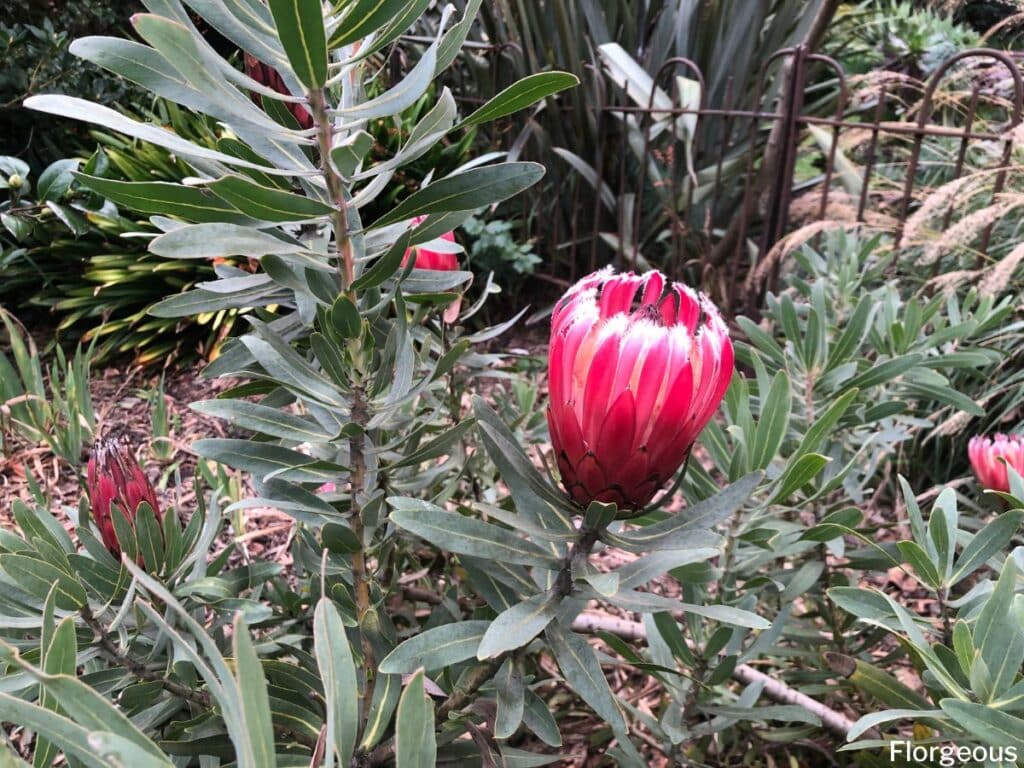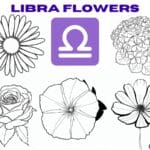Are you curious about the best tips for proper protea care? If so, you’ve come to the right place.
These flowering plants are absolutely gorgeous. Also called pincushion proteas, sugarbush, honey proteas, and many other names, these plants perform best in extremely well drained soil and are perfect in garden beds like raised beds, as screening plants, or as low shrubs.
They also offer lovely cut flowers in large clusters!
No matter how you choose to use them, these plants are perfect for any setting.
Here’s how you can grow and care for your protea plants.
Protea Plant Facts
| Scientific name | Protea |
| Common names | Sugarbush, common sugarbush, honey protea, suikerbos, real sugarbush, opregte suikerbos, stroopbos, cone bush, pin cushion proteas |
| Family | Proteas |
| Plant Type | Blooming evergreen tree/shrub |
| Height and Width | 6-26 feet tall |
| Origin | South Africa |
| Flower colors | Pink, cream, white |
| Foliage color | Dark green |
| Sun Exposure | Full sun |
| Soil Type & pH | Sandy or loamy soil that is well-draining |
| Special features | Unusual and beautiful flowers, symbolic meaning, great for indoors, toxic to pets and people |
Tips for Growing Proteas
Protea plants do best when planted in containers or beds. They prefer well-drained soils with a neutral pH balance and plenty of organic material. When planting proteas in pots or other containers, be sure to use a light potting mix with good drainage capabilities.
Propagation
There are several different ways you can propagate proteas from seed or from cuttings. Seeds are typically sown directly into the soil and should be kept moist until germination occurs.
Cuttings should be taken from already established plants early in the morning when temperatures are cool for best results. These cuttings should then be placed in moist sand with some peat moss mixed in for moisture retention until they have rooted properly – then they can be transplanted into their desired location.
Soil
The ideal soil for protea flowers will be well-draining. Heavy clay soils are not ideal for the protea plant. Instead, choose sandy soil and make sure it is not nutrient poor soil. Add mulch and fertilizer as needed to ensure your protea plant gets everything it needs.
Pruning
When it comes to pruning proteas, it is important not to trim too much foliage away as this could potentially damage the plant due to its shallow root system.
Prune lightly around the base of each stem if needed but make sure not to take too much away at once as this could cause shock or death of the plant altogether. The best time of year to prune is during late winter/early spring before new growth begins again in the summertime – this will ensure optimal health and shape for your protea plants!
Repotting and Transplanting
It is recommended that you repot your protea plants every two years or so, depending on their size and growth rate.
When transplanting them from one container/bed/area to another, it is important that you water them thoroughly beforehand.

How to Care for Protea Flower
Proteas are a popular flower choice for weddings and special events because of their unique beauty and vibrant colors.
However, caring for proteas is not always easy and if you don’t know the proper techniques, you could end up with wilted blooms instead of beautiful blossoms.
Here are some tips.
Water
One of the most important steps in caring for proteas is ensuring that they have plenty of water. To do this, it’s best to use room temperature water when watering them. Cold or hot water can shock the plant and cause it to wilt prematurely.
Make sure to thoroughly soak each bloom with water after picking or purchasing your protea to ensure that each one is well hydrated right away.
Sunlight
Proteas need around six hours of direct sunlight daily in order to grow properly.
Temperature and Humidity
Most species of protea flower grow best in temperatures between 65-85 degrees Fahrenheit.
Proteas prefer relative humidity levels of 50% or higher, making them ideal for growing indoors or in humid climates like tropical rainforests.
Fertilizer
When choosing a fertilizer for your protea, consider what type of soil you have in your garden and the pH level of the soil. You should also look for a fertilizer that is specifically formulated for acid-loving plants like proteas.
Most general-purpose fertilizers are not appropriate for these types of plants, as they tend to be too alkaline and can damage the delicate roots of a protea. In general, proteas don’t need a lot of fertilizer – and too much phosphorus can actually kill them. The roots are shallow so don’t disturb them when fertilizing.
Pest and diseases
Protea plants can be vulnerable to a range of pests, including mealybugs, aphids, scale insects, whiteflies, mites, and more. To prevent pest infestation on your protea plants, it’s important to regularly check the leaves for signs of pests, such as small bumps or webs.
If you do find any pests on your plant, you should immediately take action by spraying an insecticide or using an organic solution, such as neem oil or horticultural oil.
Protea plants can also be prone to various fungal diseases, such as powdery mildew and root rot. One way to minimize the risk of these diseases is to make sure that your plant has adequate air circulation and drainage so that it does not become overly wet or damp.
Also, you should avoid overwatering your protea plant as this could lead to root rot. If you find that your plant is suffering from a fungal disease, you may need to treat it with a fungicide in order to control the spread of the fungus.
Common Varieties and Cultivars
There are more than 1,400 species of proteas found in many countries including South Africa, Australia, New Zealand, and Hawaii. The Sugarbushes come in various sizes and shapes with different types of blooms.
Some of the most popular types of protea plants include:
- King Protea (Protea cynaroides)
- Queen Protea (Protea magnifica)
- Pink Ice (Leucospermum cuneiforme)
- Pincushion (Leucospermum cordifolium)
Conclusion
With these simple steps, you’ll be able to ensure that your protea plants stay healthy and beautiful all year long!
Learn more about protea flower meaning and symbolism to see why people love growing these plants.







